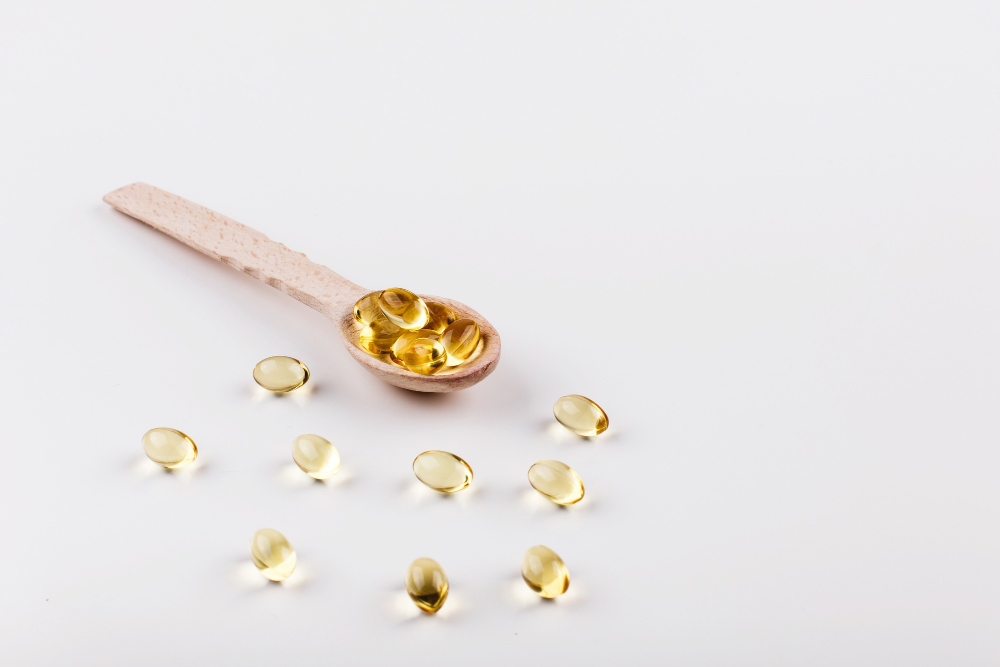DHA與EPA是什麼?DHA、EPA功效與差異醫師來解答

Omega-3是人體所需之必需脂肪酸的一種,其中又含有ALA(α-亞麻酸)、EPA (二十碳五烯酸)、DHA(二十二碳六烯酸)(1)。這些不同的成份有不同的功效,因此想透過補充Omega-3脂肪酸來幫助健康,可以依據需求,選擇合適的成分,效果會更精準喔。
魚油EPA、DHA差別在哪?
魚油中DHA含有22個碳原子以及6個雙鍵,因此學名稱作二十二碳六烯酸(2)。
Omega-3中的EPA則含有20個碳原子以及5個雙鍵,所以學名稱作二十碳五烯酸(2)。

DHA其對於嬰幼兒的健康發育與學習力發展來說非常重要,DHA同時也是維持晶亮健康的成分。在飲食中攝取充足的DHA可幫助我們提高學習能力與專注力,相關研究認為老年人因為年紀的增加,體內DHA含量也隨之降低,對於反應能力會有所影響(3)。
了解更多:DHA是什麼?提升學習力不可少,DHA的6大功效與好處
EPA則是與循環健康、心情健康有關,對於經常外食、少運動,或者工作高壓的族群,提供暢通維持、加強心情及壓力管理,補充高濃度的EPA有正面效益。
了解更多:EPA是什麼?6大EPA功效與好處,維持循環、好心情不可少
若是有特別的健康促進目的,透過選擇高濃度DHA或是EPA的魚油產品來攝取,幫助會更大。
EPA、DHA功效比一比
|
DHA魚油 |
EPA魚油 |
|
|
功效 |
DHA魚油、EPA魚油適合補充的族群
|
DHA魚油 |
EPA魚油 |
|
|
補充族群 |
|
|
DHA、EPA魚油什麼時候吃最好?
魚油主要富含Omega-3不飽和脂肪酸,其為脂溶性的化合物,所以在攝取後會需要酵素分解成游離脂肪酸的型態,才能夠被身體利用(14)。因此,會建議於飯後再攝取魚油,其吸收效率會因為有消化酵素的幫助而比較好。

DHA、EPA魚油怎麼挑選?
DHA和EPA屬於Omega-3不飽和脂肪酸,一般在我們的飲食中主要的來源多為魚油,未精製魚油中Omega-3脂肪酸A的含量大約占總脂肪酸量的20-30%左右,所以必須經過精製的過程後,DHA與EPA的含量才會提高(15)。
-
DHA、EPA80%以上濃度魚油:相關研究指出,Omega-3脂肪酸濃度要高,健康促進效果才會好,若有特殊保健目的,則應挑選魚油中DHA或EPA比例80%以上的魚油,才能更有效率的幫助想調理的部分(16)。
-
rTG型式魚油:目前研究結果指出,rTG魚油吸收率與生物利用率都顯著比EE高,rTG生物利用率更顯著高出EE超過50%(17)。
了解更多:魚油萃取方式:EE、TG、rTG,以及超臨界萃取是什麼,醫師來解惑
大研生醫魚油產品,針對各種不同保健需求,研發不同成份比例魚油,分別為
-
德國頂級魚油:兼具EPA、DHA含量,Omega-3濃度84%以上。
-
EPA1200頂級魚油:以EPA成分為主,適合幫助維持正常新陳代謝健康。
-
DHA80%兒童魚油:以DHA成分為主,兒童、孕婦都很適合。
- Mayo Clinic:Fish oil
- https://ods.od.nih.gov/factsheets/Omega3FattyAcids-HealthProfessional/
- Horrocks, L. A., & Yeo, Y. K. (1999). Health benefits of docosahexaenoic acid (DHA). Pharmacological research, 40(3), 211-225.
- Carlson, S. E., Colombo, J., Gajewski, B. J., Gustafson, K. M., Mundy, D., Yeast, J., ... & Shaddy, D. J. (2013). DHA supplementation and pregnancy outcomes. The American journal of clinical nutrition, 97(4), 808-815.
- Birch, E. E., Carlson, S. E., Hoffman, D. R., Fitzgerald-Gustafson, K. M., Fu, V. L., Drover, J. R., ... & Diersen-Schade, D. A. (2010). The DIAMOND (DHA Intake And Measurement Of Neural Development) Study: a double-masked, randomized controlled clinical trial of the maturation of infant visual acuity as a function of the dietary level of docosahexaenoic acid. The American journal of clinical nutrition, 91(4), 848-859.
- Manley, B. J., Makrides, M., Collins, C. T., McPhee, A. J., Gibson, R. A., Ryan, P., ... & DINO Steering Committee. (2011). High-dose docosahexaenoic acid supplementation of preterm infants: respiratory and allergy outcomes. Pediatrics, 128(1), e71-e77.
- Zhang, Y., Chen, J., Qiu, J., Li, Y., Wang, J., & Jiao, J. (2015). Intakes of fish and polyunsaturated fatty acids and mild-to-severe cognitive impairment risks: a dose-response meta-analysis of 21 cohort studies–3. The American journal of clinical nutrition, 103(2), 330-340.
- Gow, R. V., Sumich, A., Vallee-Tourangeau, F., Crawford, M. A., Ghebremeskel, K., Bueno, A. A., ... & Rubia, K. (2013). Omega-3 fatty acids are related to abnormal emotion processing in adolescent boys with attention deficit hyperactivity disorder. Prostaglandins, Leukotrienes and Essential Fatty Acids, 88(6), 419-429.
- Peet, M., & Horrobin, D. F. (2002). A dose-ranging study of the effects of ethyl-eicosapentaenoate in patients with ongoing depression despite apparently adequate treatment with standard drugs. Archives of general psychiatry, 59(10), 913-919.
- Jones, P. J., Senanayake, V. K., Pu, S., Jenkins, D. J., Connelly, P. W., Lamarche, B., ... & Kris-Etherton, P. M. (2014). DHA-enriched high–oleic acid canola oil improves lipid profile and lowers predicted cardiovascular disease risk in the canola oil multicenter randomized controlled trial. The American journal of clinical nutrition, 100(1), 88-97
- Golzari, M. H., Javanbakht, M. H., Ghaedi, E., Mohammadi, H., & Djalali, M. (2018). Effect of Eicosapentaenoic acid (EPA) supplementation on cardiovascular markers in patients with type 2 diabetes mellitus: a randomized, double-blind, placebo-controlled trial. Diabetes & Metabolic Syndrome: Clinical Research & Reviews, 12(3), 411-415.
- Sköldstam, L., Börjesson, O., Kjällman, A., Seiving, B., & Åkesson, B. (1992). Effect of six months of fish oil supplementation in stable rheumatoid arthritis. A double-blind, controlled study. Scandinavian journal of rheumatology, 21(4), 178-185.
- Kalupahana, N. S., Claycombe, K., Newman, S. J., Stewart, T., Siriwardhana, N., Matthan, N., ... & Moustaid-Moussa, N. (2010). Eicosapentaenoic acid prevents and reverses insulin resistance in high-fat diet-induced obese mice via modulation of adipose tissue inflammation. The Journal of nutrition, 140(11), 1915-1922.
- Maki, K. C., Johns, C., Harris, W. S., Puder, M., Freedman, S. D., Thorsteinsson, T., ... & Sancilio, F. D. (2017). Bioequivalence demonstration for Ω-3 acid ethyl Ester formulations: rationale for modification of current guidance. Clinical therapeutics, 39(3), 652-658.
- Wang, J., Reyes Suárez, E., Kralovec, J., & Shahidi, F. (2010). Effect of chemical randomization on positional distribution and stability of omega-3 oil triacylglycerols. Journal of agricultural and food chemistry, 58(15), 8842-8847.
- Bryhn, M., Hansteen, H., Schanche, T., & Aakre, S. E. (2006). The bioavailability and pharmacodynamics of different concentrations of omega-3 acid ethyl esters. Prostaglandins, Leukotrienes and Essential Fatty Acids, 75(1), 19-24.
- Neubronner, J., Schuchardt, J. P., Kressel, G., Merkel, M. V., von Schacky, C., & Hahn, A. (2011). Enhanced increase of omega-3 index in response to long-term n-3 fatty acid supplementation from triacylglycerides versus ethyl esters. European journal of clinical nutrition, 65(2), 247-254.












